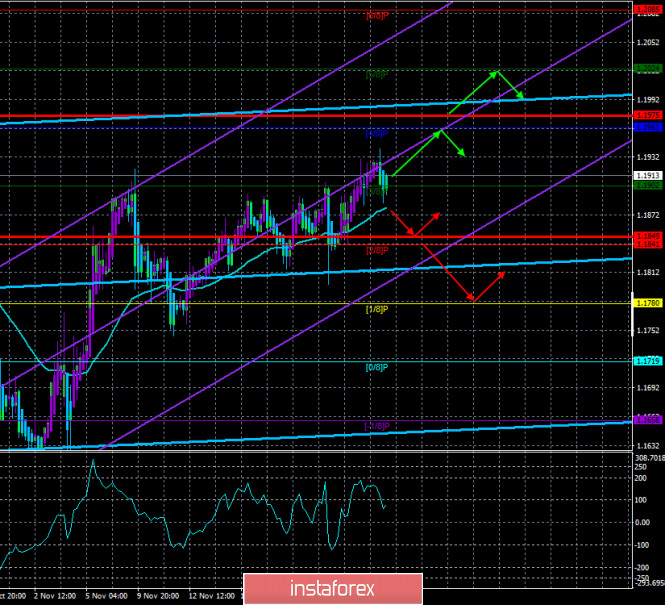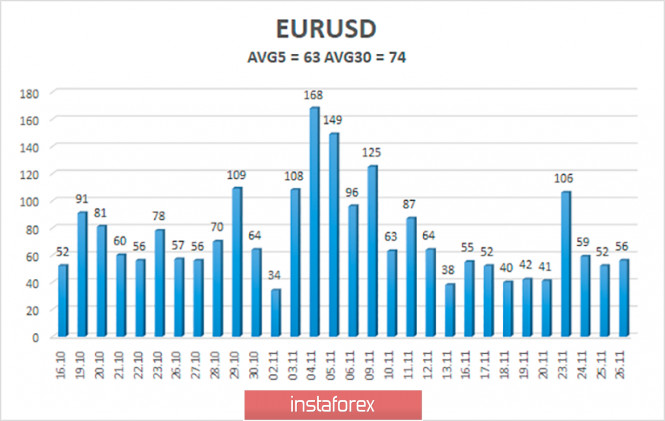4-hour timeframe

Technical details:
Higher linear regression channel: direction - sideways.
Lower linear regression channel: direction - upward.
Moving average (20; smoothed) - upward.
CCI: 87.2010
The fourth trading day for the EUR/USD pair was again fairly calm. The pair started a round of downward correction over the past day, and the maximum mark that buyers were able to reach was the level of 1.1941. Formally, there is now an upward trend, which is indicated by the lower channel of linear regression and the moving average line directed upwards. However, the price only recently left the four-month side channel. At the moment, trading is slightly higher than this channel, however, we do not see any pronounced upward trend. Buyers bitterly pushed through the level of 1.1900 and stopped. There is nothing to say about the fundamental background. Market participants ignore most of it, and macroeconomic statistics are practically not worked out in 2021 (starting from March).
Earlier (a few months ago), we repeatedly wrote that the European economy coped better with the first "lockdown". The losses of the European economy in the second quarter were minimal, as in the UK or the US. This is the factor that we mainly attributed to the strengthening of the European currency against the US dollar after March. Indeed, despite all the records of the US stock market, it should be understood that the economy is not just the stock market. The largest US companies have increased their capitalization, but hundreds of millions of Americans have lost a certain part of their income, many – their jobs, some – their health and loved ones. So the economy in the States has suffered in any case, and it has suffered greatly. Another thing is that it also shows a fairly high rate of recovery. And the third thing is that the US authorities decided not to re-enter the "lockdown". Perhaps this is good for the US economy. It will not shrink in the fourth quarter but will continue to recover. But this is a matter of human lives. In Europe, they went the other way. The authorities of almost all EU member states immediately introduced a "total quarantine". Naturally, the EU economy will suffer a contraction in the fourth quarter. Experts have already calculated that in the most optimistic scenario, the European economy will lose another 3% due to the second "lockdown". Thus, the advantage of the euro currency over the US dollar may be leveled in the coming weeks. The strangest thing is that in general, the US dollar can't start getting more expensive for several months. At first, its growth was due to technical factors. Then - thanks to the fundamental. And nothing can make traders buy the US currency. This persistent reluctance of market participants to buy the dollar must have something to do with it. Especially when the euro currency has been rising in price for 7-8 months and added a total of 13 cents (for example, throughout 2019, the dollar rose against the Euro by 2 cents). At a minimum, there should have been a downward correction. However, it wasn't there. And at this time, buyers continue to push the pair up. Therefore, based on all technical and fundamental factors, we still believe that the strengthening of the US currency should begin in the near future. The euro is overbought, and traders have no reason to continue buying it.
What is "lockdown" for the economy and business? At first glance, everything is simple – most of the stores and companies that provide various services to the population (most of which are small businesses) will not get a lot of money. It is good if they have airbags, but the European Central Bank has been busy in recent years encouraging businesses and individuals in the EU not to keep money under the pillow, but to invest it in the economy. Hence the ultra-low interest rates, at which it is simply unprofitable to keep money on deposits. Thus, it is safe to say that the ECB has done a disservice to many businesspeople. However, not only small businesses will suffer. Participants in areas such as air travel and tourism will also suffer and will suffer the most. And this is a big business. The International Air Transport Association, for example, predicts a massive airline bankruptcy in 2021. At the very least, these companies survived the first "lockdown". Somewhere with the help of the state, somewhere with the sale of aircraft, somewhere thanks to the dismissal of staff. However, the second "wave" of the epidemic can finish them off. Even if there were no "lockdown", during the epidemic, people do not fly abroad on vacation and reduce the number of business trips. The hotel and restaurant business is also suffering. Thus, since money is not taken from nowhere, many people will not survive the second "lockdown". Of course, the governments of many countries have made conclusions and predict that the second "lockdown" will not be so destructive for the economy. If, for example, France lost about 30% during the first quarantine, now it can lose only 15%. However, this is a huge figure, we are talking about hundreds of billions of euros.
However, the head of the International Monetary Fund Kristalina Georgieva is quite optimistic. "We don't expect such a big drop as in March. First, the main damage to the sectors of the economy that are most vulnerable to quarantine measures has already been done. Secondly, we are gradually learning how to live and work in a pandemic environment, which allows us to avoid such huge losses in business activity in the new lockdown as in the spring. Third, the extraordinary anti-crisis fiscal and credit measures taken by governments and central banks will mitigate the impact of repeated quarantine on the economy." The most important thing is that there is no other way for Europe. You can, of course, put in the example of America, where there is no "lockdown", and people are infected every day for hundreds of thousands. However if the US President was not Donald Trump, it is likely that the "lockdown" would have been introduced a long time ago. Doctors say with one voice that only total quarantine can interrupt the chains through which the virus is transmitted. There are no other ways to stop the pandemic. So Europe should remain in quarantine, but for its economy, it will be another shock. And how can we not remember that the seven-year budget and the fund for economic recovery after the pandemic are currently blocked by Poland and Hungary. And it will take some time to come to a common opinion on this issue.

The volatility of the euro/dollar currency pair as of November 27 is 63 points and is characterized as "average". Thus, we expect the pair to move today between the levels of 1.1849 and 1.1975. A reversal of the Heiken Ashi indicator to the top may signal the resumption of the upward movement.
Nearest support levels:
S1 – 1.1902
S2 – 1.1841
S3 – 1.1780
Nearest resistance levels:
R1 – 1.1963
R2 – 1.2024
R3 – 1.2085
Trading recommendations:
The EUR/USD pair continues to be located above the moving average line. Thus, today it is recommended to open new buy orders with targets of 1.1963 and 1.1975 after the Heiken Ashi indicator turns up. It is recommended to consider sell orders if the pair is fixed below the moving average with the first targets of 1.1849 and 1.1780.
The material has been provided by InstaForex Company - www.instaforex.com